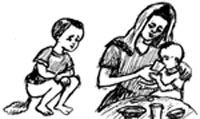2.1.1 Clinical classification of communicable diseases
As stated in Box 2.1, this classification is based on the main clinical manifestations of the disease. This way of classification is important in helping you to treat the symptoms and signs that are common to (shared by) individuals who suffer from different diseases. Clinical classification is illustrated by the example given below.
Diarrhoeal diseases

Some diseases are classified as diarrhoeal diseases. The main clinical symptom is diarrhoea, which means passage of loose stool (liquid faeces) three or more times per day. Two examples of diarrhoeal diseases are shigellosis and cholera. (Further details about these diseases are in Study Session 33 of this Module). People with watery diarrhoeal disease suffer from loss of fluid from their bodies. Therefore, even though the infectious agent might be different, as in the examples of shigellosis and cholera, the common management of patients with diarrhoeal disease includes fluid replacement (Figure 2.1).
Other clinical classifications
Another clinical classification refers to diseases characterised as febrile illnesses, because they all have the main symptom of fever, for example, malaria. Respiratory diseases are another clinical classification; their main symptoms include cough and shortness of breath, as in pneumonia.
Diseases have many symptoms and signs. As a Health Extension Practitioner, you will need to decide which symptom is the main one for classification. Using the method of clinical classification will help you decide to treat the main symptom. You will be able to identify the main symptoms more easily when you learn about specific diseases later on in this Module. Bear in mind that for most diseases, treatment of the main symptom is only supportive (that is it will not cure the disease). Therefore, you have to give treatment specific to the infectious agent. This will be discussed later in this Module under the specific diseases.
2.1 Classification of communicable diseases
